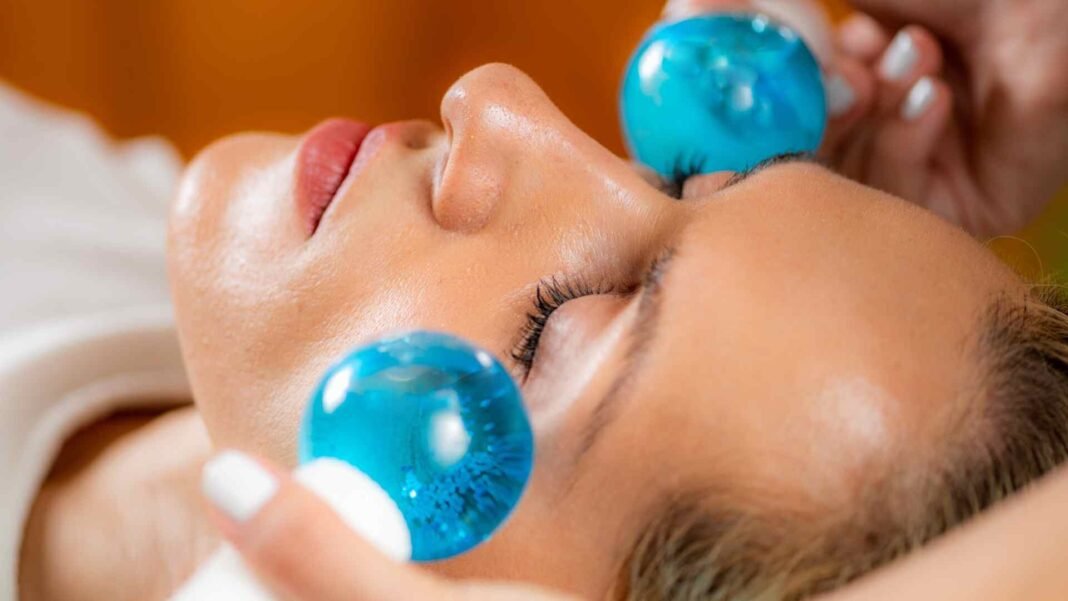The beauty world is buzzing with the latest skincare trend—ice-water facials. This simple, cost-effective technique involves dunking your face in a bowl of ice water or rubbing ice cubes on your skin to achieve a radiant complexion. While celebrities like Bella Hadid, Katrina Kaif, and Alia Bhatt swear by this method, experts are divided on whether it’s a skincare miracle or just another fleeting fad.
What Are Ice-Water Facials?
Ice-water facials are as straightforward as they sound. The process involves immersing your face in ice-cold water for short periods or using frozen tools to massage the skin. Advocates claim that this practice reduces puffiness, tightens pores, improves skin tone, and even minimizes signs of aging. Social media platforms have amplified their popularity, with influencers showcasing their glowing results after a quick dip into icy waters.
The Science Behind Ice Therapy
Cold temperatures have specific physiological effects on the skin. When exposed to ice-cold water, blood vessels constrict (vasoconstriction), reducing blood flow to the area. This temporarily decreases inflammation and swelling. As the skin warms up afterward, blood vessels dilate (vasodilation), improving circulation and delivering oxygen and nutrients to the skin.
Dr. Sonali Kohli, a consultant dermatologist, explains that this process can lead to temporary tightening of pores and an even-toned complexion. Similarly, Dr. Rachel Day highlights how improved circulation enhances radiance and reduces redness.
However, experts caution that these effects are transient. Pore size is primarily determined by genetics and age; while icing may reduce their appearance temporarily, it cannot permanently shrink them.
Benefits of Ice-Water Facials
Proponents of ice-water facials cite several advantages:
- Reduction in Puffiness: Cold temperatures effectively reduce swelling under the eyes caused by sleep deprivation or eye strain.
- Improved Skin Tone: Enhanced blood flow post-icing can give the skin a healthy glow.
- Temporary Tightening of Pores: The constriction of blood vessels can make pores appear smaller for a short period.
- Anti-Aging Effects: Regular use may help reduce superficial wrinkles by stimulating circulation.
- Acne Relief: The anti-inflammatory properties of cold therapy can soothe inflamed acne lesions and minimize redness.
Actor Smriti Khanna described her experience with ice-water facials as “the cheapest and best skincare hack ever,” noting its ability to improve skin tone and reduce puffiness instantly.
Limitations of Ice-Water Facials
Despite their apparent benefits, ice-water facials have limitations:
- Temporary Results: The effects on puffiness, pores, and redness are short-lived. Once blood flow normalizes, the improvements fade.
- Not a Cure-All for Acne: While icing may reduce inflammation in acne-prone skin, it does not address underlying causes like excess oil production or bacterial growth.
- Potential Skin Irritation: Prolonged exposure to cold temperatures can damage capillary walls and lead to spider veins (telangiectasia).
- Unsuitability for Sensitive Skin: Individuals with reactive or sensitive skin may experience dryness or irritation after icing. Dermatologists recommend moisturizing immediately after exposure to prevent damage to the skin barrier.
Dr. Ekta Yadav advises starting with short exposures (5–10 seconds) and gradually increasing time as your skin adjusts. Overuse can lead to adverse effects such as redness or irritation.
Celebrity Endorsements vs Expert Opinions
The popularity of ice-water facials has skyrocketed thanks to endorsements from celebrities like Bella Hadid and Katrina Kaif. These stars often use the technique to combat morning puffiness before applying makeup. However, dermatologists urge caution when adopting celebrity trends without understanding their scientific basis.
Dr. Swapna Priya emphasizes that while ice therapy is generally safe when done correctly, it should not replace a comprehensive skincare routine that includes cleansing, moisturizing, and sun protection.
Are Ice-Water Facials Worth It?
The verdict on ice-water facials depends on individual expectations:
- If you’re looking for a quick fix for puffiness or redness before an event, this method might work for you.
- However, if you’re seeking long-term skincare solutions for acne or aging concerns, ice therapy alone is insufficient.
Experts recommend integrating ice therapy into a balanced skincare regimen rather than relying on it as a standalone solution. For those with sensitive skin or conditions like rosacea, it’s best to consult a dermatologist before trying this trend.
Tips for Safe Ice Therapy
To maximize benefits while minimizing risks:
- Use clean water or sterile tools to avoid introducing bacteria to your skin.
- Limit exposure time to 30 seconds per session to prevent damage from prolonged vasoconstriction.
- Test cold exposure on a small area first if you’re new to the practice.
- Moisturize immediately after icing to lock in hydration.
- Avoid adding ingredients like lemon juice or lavender oil that might irritate sensitive skin.
Ice-water facials offer undeniable short-term benefits for puffiness reduction and pore tightening but fall short as a comprehensive skincare solution. While celebrities hail it as their go-to beauty hack, experts caution against expecting miraculous results from this chilly treatment.
For those intrigued by its simplicity and affordability, ice therapy can be an occasional addition to your skincare routine, provided you follow safety guidelines and pair it with proven practices like cleansing and moisturizing.
Ultimately, glowing skin requires more than just a frozen fix; it demands consistency, balance, and care tailored to your unique needs.






